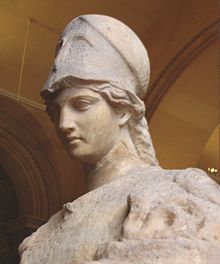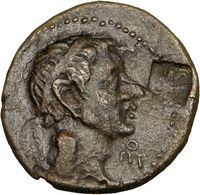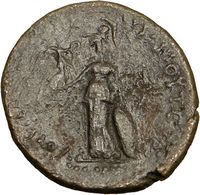|
Coele-Syria.
Dynasts of Chalkis.
Lysanias, tetrarch, 40-36 B.C.
Bronze 21mm (5.47 grams) Struck 40-36 B.C.
Reference: SNG Cop. 415-416; Sear 5898 (£100 in
1978 edition)
Ex-William B. Porter Collection
Diademed head of Lysanias right, ΠTO monogram
before.
ΛΥΣΑΝΙΟY ΤΕΤΡΑΡΧΟY ΚΑΙ ΑΡXIEPEΩΣ, Athena standing
left, holding Nike, spear and shield; ΦΛ monogram in field to right.
The son of Ptolemy; he was put to
death by Mark Antony who gave the kingdom of Chalkis to Cleopatra of Egypt.
Coele-Syria is a district of
southern Syria, bounded by Phoenicia in the west and Palestine to the south.
Situated at the foot of Mt. Antilibanon, Chalkis was, in the 1st century B.C.,
the center of a small kingdom.
You are bidding on the exact item pictured,
provided with a Certificate of Authenticity and Lifetime Guarantee of
Authenticity.
Athena or Athene
(Latin:
Minerva), also referred to as
Pallas Athena, is the goddess of war, civilization, wisdom, strength,
strategy, crafts, justice and skill in
Greek mythology.
Minerva,
Athena's Roman
 incarnation,
embodies similar attributes. Athena is also a shrewd companion of
heroes and the
goddess of
heroic endeavour. She is the
virgin patron of
Athens. The Athenians built the
Parthenon on the Acropolis of her namesake
city, Athens, in her honour (Athena Parthenos). Athena's cult as the patron of
Athens seems to have existed from the earliest times and was so persistent that
archaic myths about her were recast to adapt to cultural changes. In her role as
a protector of the city (polis),
many people throughout the Greek world worshiped Athena as Athena Polias
("Athena of the city").
Athens and Athena bear etymologically connected
names. incarnation,
embodies similar attributes. Athena is also a shrewd companion of
heroes and the
goddess of
heroic endeavour. She is the
virgin patron of
Athens. The Athenians built the
Parthenon on the Acropolis of her namesake
city, Athens, in her honour (Athena Parthenos). Athena's cult as the patron of
Athens seems to have existed from the earliest times and was so persistent that
archaic myths about her were recast to adapt to cultural changes. In her role as
a protector of the city (polis),
many people throughout the Greek world worshiped Athena as Athena Polias
("Athena of the city").
Athens and Athena bear etymologically connected
names.
Lysanias was the ruler of a small realm on the
western slopes of Mount Hermon, attested to by the Jewish writer Josephus and in coins
from circa 40 BC. There is also mention of a Lysanias dated to 29 AD in
the gospel of Luke. It has been debated whether these are the same person.
Lysanias
in Josephus
Lysanias was the ruler of a tetrarchy, centered on the town of Abila. This
has been referred to by various names including
Abilene,
Chalcis and
Iturea, from about 40-36 BC. Josephus is our
main source for the life of Lysanias.
His father was
Ptolemy son of Mennaeus who ruled the tetrarchy
before him. Lysanias was cousin of
Antigonus, who he helped during the latter's
attempt to claim the throne of
Judea in 40 BC with the military support of the
Parthians.
According to
Josephus (B.J. 1.248), he offered the Parthian
satrap
Barzapharnes "a thousand talents and 500 women
to bring Antigonus back and raise him to the throne, after deposing Hyrcanus".
However, Josephus in his later work, the
Jewish Antiquities 14.330-331, relates that it
was Antigonus who made the offer to the Parthians. Whichever the case, Lysanias
was put to death by
Mark Antony for his Parthian sympathies, at the
instigation of
Cleopatra, who had eyes on the territories of
Lysanias.
Coins from his reign indicate that he was "tetrarch and high priest". The
same description can be found on the coins of his father, Ptolemy son of
Mennaeus and on those of a possible near relative
Zenodorus who held the territory in 23-20 BC.
Lysanias
in Luke
The
Luke
3:1 records that a Lysanias was
tetrarch of Abilene in the time of
John the Baptist.
According to
Josephus the emperor
Claudius in AD
42
confirmed
Agrippa I in the possession of
Abila of Lysanias already bestowed upon him by
Caligula, elsewhere described as Abila, which
had formed the tetrarchy of Lysanias. The statement appears in the Wars:
- "He added to it the kingdom of Lysanias, and that province of Abilene"
and also in Antiquities (Ant. xix.5, 1).
Archaeological
Lysanias
Two inscriptions have been ascribed to Lysanias. The name is conjectural in
the latter case.
The first, a temple inscription found at Abila, named Lysanias as the
Tetrarch of the locality.
The temple inscription reads:
| Inscription |
|
Translation |
| Huper tes ton kurion Se[baston] |
|
For the salvation of the Au[gust] lords |
| soterias kai tou sum[pantos] |
|
and of [all] their household, |
| auton oikou, Numphaios Ae[tou] |
|
Nymphaeus, free[dman] of Ea[gle] |
| Lusianiou tetrarchou apele[utheors] |
|
Lysanias tetrarch established |
| ten odon ktisas k.t.l |
|
this street and other things. |
It has been thought that the reference to August lords as a joint title was
given only to the emperor Tiberius (son of Augustus) and his mother Livia (widow
of Augustus) . This reference would establish the date of the inscription to
between A.D. 14 (when Tiberius began to reign) and 29 (when Livia died), and
thus could not be reasonably interpreted as referring to the ruler executed by
Mark Antony in 36 BC. However, Augustus and Livia together were referred to
during their lifetimes as SEBASTWI, ie Augusti, so there is no reason to assume
this fragment should be dated as late as the reign of Augustus.
Possible
identity of the two figures
There is some debate over whether these sources refer to the same person, or
two different people.
Some[citation
needed] say that the Lysanias whose tetrarchy was given to
Agrippa cannot be the Lysanias executed by Antony, since his paternal
inheritance, even allowing for some curtailment by
Pompey, must have been of far greater extent.
Therefore the Lysanias in Luke (AD
28-29)
is a younger Lysanias, tetrarch of Abilene only, one of the districts into which
the original kingdom was split up after the death of Lysanias I. This younger
Lysanias may have been a son of the latter, and identical with, or the father
of, the Claudian Lysanias.
But Josephus does not refer to a second Lysanias. It is therefore suggested
by others that he really does refer to the original Lysanias, even though the
latter died decades earlier. In BJ 2.215 Josephus refers to the realm as being "called
the kingdom of Lysanias", while Ptolemy writing circa 120 AD in his Geography Bk
5 refers to Abila as "called of Lysanias"
The explanation given by M. Krenkel is that Josephus does not mean to imply
that Abila was the only possession of Lysanias, and that he calls it the
tetrarchy or kingdom of Lysanias because it was the last remnant of the domain
of Lysanias which remained under direct
Roman administration until the time of Agrippa.
|


